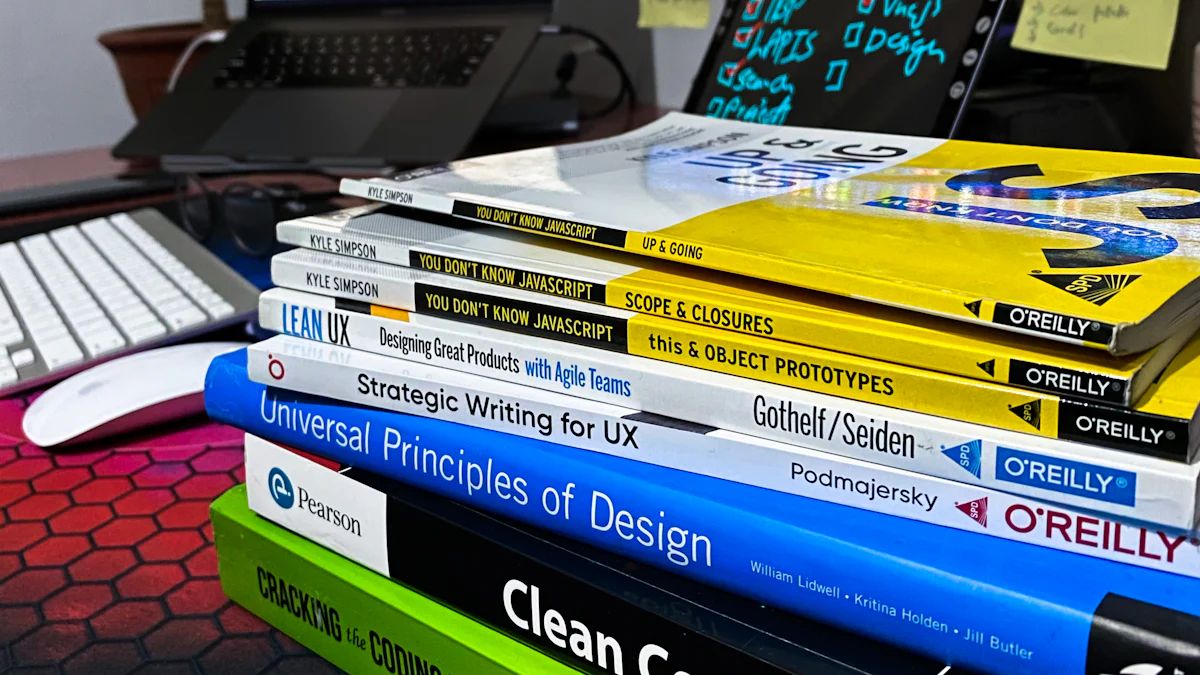How to Prepare for Interviews Using Cracking the Coding Interview
Try Aihirely for
Smarter Interview Prep
Experience real-time AI support tailored to your Resume.
Boost your confidence and ace every question with
AI Mock Interview.

Image Source: unsplash
Preparing for technical interviews can seem daunting, but cracking the coding interview process becomes much easier with the help of “Cracking the Coding Interview.” This highly regarded book is a go-to resource for mastering coding challenges and refining interview techniques. In fact, 78% of readers have reported a noticeable improvement in their success rates after using it. Professionals like Lisa Martinez from Apple attribute their success at landing roles in top-tier companies to this invaluable guide. To maximize its benefits, focus on the essential chapters, tackle practice problems methodically, and combine it with other preparation tools. By following this strategy, you’ll gain confidence and excel in your interviews.
Key Takeaways
-
Focus on key chapters in ‘Cracking the Coding Interview’. Learn data structures and algorithms to prepare for tech interviews.
-
Solve problems step by step: understand, plan, code, and test. This makes you more confident and skilled.
-
Practice mock interviews with friends to feel like it’s real. This improves how you talk and handle interview stress.
-
Use websites like LeetCode and HackerRank for practice. They have many problems and mock interviews to help you get better.
-
Make small goals and check your progress often. Celebrate wins to stay excited and keep practicing regularly.
Why Cracking the Coding Interview is a Must-Have Resource
Comprehensive and Practical Content
When it comes to preparing for technical interviews, you need a resource that’s both thorough and easy to follow. That’s exactly what “Cracking the Coding Interview” offers. The book is structured in a way that takes you step-by-step through the entire interview process. It doesn’t just throw problems at you—it guides you from understanding the basics to solving complex coding challenges.
Here’s what makes it stand out:
-
Problems are organized by difficulty, so you can build your confidence as you go.
-
It includes detailed walkthroughs for each problem, helping you understand the “why” behind the solution.
-
You’ll also find advice on behavioral interviews, negotiating job offers, and even handling rejection—topics most other books skip.
The book doesn’t just teach you how to solve problems. It focuses on the process of problem-solving, which is the key to impressing interviewers.
Trusted by Industry Professionals
You’re not just taking advice from anyone. The author, Gayle Laakmann McDowell, has worked at top companies like Google, Microsoft, and Apple. Her experience shines through in the book’s content. It’s no wonder so many professionals swear by it.
For example, Lisa Martinez, a software engineer at Apple, said the book helped her land roles at companies like Facebook and Bloomberg. On Reddit, another user shared how the mock questions and strategies boosted their confidence during interviews. In fact, a survey found that 78% of readers saw a significant improvement in their success rates after using the book.
Tailored for Real-World Technical Interviews
What makes this book so effective? It’s designed with real-world scenarios in mind. McDowell uses examples from her own experience to show you what to expect in actual interviews.
Take a look at some of its standout features:
| Feature | Description |
|---|---|
| Comprehensive Coverage | Focuses on both technical and behavioral aspects of interviews. |
| Real-world Examples | Includes scenarios from McDowell’s career, making the content relatable and practical. |
| Practical Tips | Offers advice on negotiating offers and handling tough questions, which are often overlooked. |
By using this book, you’re not just preparing for interviews—you’re preparing for the challenges of a real tech career.
Key Chapters to Focus On in Cracking the Coding Interview
Essential Chapters for Mastering Fundamentals
If you’re just starting out or want to strengthen your basics, some chapters in “Cracking the Coding Interview” are absolute must-reads. These chapters cover the core concepts that form the foundation of technical interviews. Here’s what you should focus on:
-
Essential data structures: Arrays, Linked Lists, Stacks, Queues, Trees, and Graphs.
-
Fundamental algorithms: Sorting techniques like Quick Sort and Merge Sort, Searching methods like Binary Search, and Dynamic Programming.
-
Problem-solving techniques: Breaking down problems, recognizing patterns, backtracking, and recursion.
These topics appear in almost every technical interview. By mastering them, you’ll feel more confident tackling even the toughest questions. Take your time with these chapters. Work through the examples and practice problems until you’re comfortable with the concepts.
Chapters to Skim or Skip Based on Your Needs
Not every chapter in “Cracking the Coding Interview” will be relevant to your goals. Some sections dive into niche topics or advanced concepts that might not align with your target role. For example, if you’re not applying for a role that involves system design, you can skim the chapter on system design questions.
Similarly, if you’re already confident in behavioral interviews, you might only need a quick review of that section. The key is to assess your strengths and weaknesses. Focus on areas where you need improvement and skip the ones you’ve already mastered. This approach saves time and keeps your preparation efficient.
Prioritizing Chapters for Your Target Role
Your target role should guide your study plan. If you’re aiming for a software engineering position, prioritize chapters on coding problems and algorithms. For roles in data science, focus on chapters that cover graphs, dynamic programming, and problem-solving strategies.
Here’s a tip: Research the company and role you’re applying for. Many companies have a pattern in the types of questions they ask. Use that information to tailor your preparation. By aligning your study plan with your goals, you’ll maximize your chances of success.
Strategies for Using Cracking the Coding Interview Effectively

Image Source: pexels
Depth-First vs. Breadth-First Study Approaches
When it comes to studying, you might wonder whether to dive deep into one topic at a time or cover a wide range of topics first. Both approaches have their perks, and the best choice depends on your learning style.
A depth-first approach means focusing on one chapter or concept until you’ve mastered it. For example, you could spend a week perfecting your understanding of arrays and linked lists before moving on to trees. This method works well if you prefer building confidence in one area before tackling the next.
On the other hand, a breadth-first approach involves skimming through multiple chapters to get a general idea of the content. You’ll revisit each topic later for deeper learning. This strategy is great if you’re short on time or want to identify your weak spots early.
Try combining both methods. Start with a breadth-first overview, then go deep into the areas that need more attention. This way, you’ll balance speed and depth in your preparation.
Practicing Problems with a Systematic Approach
Practicing problems effectively is all about having a plan. Don’t just jump into solving questions randomly. Instead, follow a structured method:
When you first hear a problem, always seek clarification. Understanding the problem is crucial. Ask questions like:
How big is the input size?
Are there any negative numbers?
What are some extreme cases?
Here’s a step-by-step approach to solving problems:
-
Understand - Clarify the problem and inputs/outputs. Ask clarifying questions.
-
Plan - Map out examples, consider data structures, outline steps in pseudocode.
-
Code - Write actual code for your plan. Modularize and name key parts.
-
Test - Walk through examples, test border cases, time/space complexity.
You can also:
-
Review practice problems on platforms like LeetCode to strengthen your skills.
-
Conduct mock interviews with friends to improve your communication and problem-solving under pressure.
This systematic approach ensures you’re not just solving problems but also learning from them.
Tracking Progress and Reinforcing Learning
Tracking your progress keeps you motivated and helps you identify areas for improvement. Create a simple spreadsheet or use a notebook to log the problems you’ve solved. Include details like the topic, difficulty level, and whether you solved it correctly.
Revisit problems you struggled with after a week or two. This reinforces your learning and ensures you don’t forget key concepts. You can also set small goals, like solving five problems a day or mastering one topic per week. Celebrate your milestones to stay motivated!
By staying organized and consistent, you’ll make steady progress and feel more prepared for your interviews.
Supplementing Cracking the Coding Interview with Other Resources
Online Coding Platforms for Additional Practice
While “Cracking the Coding Interview” is an excellent resource, pairing it with online coding platforms can take your preparation to the next level. These platforms offer a wide range of problems, mock interviews, and interactive features to sharpen your skills. Here are some highly recommended options:
-
LeetCode: A massive library of problems and company-specific mock interviews.
-
HackerRank: Diverse challenges and curated interview preparation kits.
-
InterviewBit: Structured learning paths tailored for technical interviews.
-
Pramp: Live mock interviews with peer feedback to simulate real scenarios.
-
CodeSignal: Gamified challenges and interview practice tools.
-
GeeksforGeeks: Articles and categorized problems for in-depth learning.
-
DesignGurus.io: Focused on system design questions and case studies.
-
Codewars: Fun kata challenges with community-driven solutions.
Using these platforms alongside “Cracking the Coding Interview” helps you practice a variety of problems and adapt to different question styles.
Video Tutorials and Online Courses
Sometimes, reading alone isn’t enough. Watching video tutorials or taking online courses can make complex topics easier to understand. Platforms like YouTube, Udemy, and Coursera offer excellent resources for visual learners.
For example, you can find tutorials that break down algorithms step-by-step or explain tricky concepts like dynamic programming. Many courses also include coding exercises, so you can immediately apply what you’ve learned. Look for courses that align with your target role or focus on areas where you need extra help.
Videos also give you the chance to see how experts approach problems. Watching someone solve a problem in real time can teach you strategies you might not pick up from a book.
Peer Practice and Mock Interviews
Practicing with peers is one of the most effective ways to prepare for technical interviews. Mock interviews simulate real conditions, helping you build confidence and improve your communication skills. Here’s how you can make the most of them:
-
Pair up with a friend or colleague to conduct mock interviews. Take turns being the interviewer and interviewee.
-
Record your sessions to review later. This helps you spot mistakes and track your progress.
-
Time yourself while solving problems to get used to working under pressure.
Mock interviews also teach you how to explain your thought process clearly, which is a crucial skill for technical interviews. Plus, they give you a safe space to make mistakes and learn from them before the real thing.
Pro Tip: Platforms like Pramp and Interviewing.io connect you with peers or professionals for live mock interviews. These tools can be a game-changer in your preparation.
By combining peer practice with the strategies in “Cracking the Coding Interview,” you’ll feel more prepared and confident when it’s time to face the real thing.
Practical Tips for Excelling in Technical Interviews

Image Source: pexels
Strengthening Problem-Solving Skills
Strong problem-solving skills are the backbone of technical interviews. To improve, start by clarifying the problem. If something in the problem statement feels unclear, ask questions to eliminate ambiguity. Once you understand the problem, plan your approach. Outline your solution in pseudocode or verbally before jumping into coding.
Begin with a simple solution. Even if it’s not the most efficient, having a working fallback is better than nothing. Afterward, look for ways to optimize your code. Can you reduce time complexity? Is there a better data structure to use? Finally, test your solution thoroughly. Use a variety of inputs, including edge cases, to ensure your code works as expected.
You can also strengthen your skills by practicing on platforms like LeetCode or HackerRank. Focus on problems that align with your target role, such as data structures or algorithms. Mock interviews with peers or mentors are another great way to simulate real interview conditions and refine your approach.
Remember the STAR method (Situation, Task, Action, Result) when explaining your solutions. It helps you communicate your thought process clearly and effectively.
Practicing Coding Under Time Constraints
Time pressure can make even simple problems feel overwhelming. To prepare, practice coding under timed conditions. Set a timer while solving problems to simulate the pace of a real interview. This helps you manage your time wisely and improves your speed.
Develop a structured approach to problem-solving. For example, always start by breaking the problem into smaller parts. Prioritize tasks and focus on the most critical aspects first. Regularly engage in speed coding sessions to build your efficiency.
Mock interviews are also invaluable here. They teach you how to articulate your thought process while coding under pressure. Platforms like Pramp or Interviewing.io offer live mock interviews that replicate real scenarios.
Understanding and Adapting to Interview Formats
Technical interviews come in various formats, and each requires a slightly different approach. For online coding assessments, practice solving coding challenges on platforms like HackerRank. If you’re facing a multiple-choice quiz, brush up on theoretical knowledge of programming concepts.
Take-home assignments often test your ability to manage time and solve problems in a project-based format. Plan your work carefully and showcase your problem-solving skills. For whiteboard interviews, practice explaining your thought process out loud. This format emphasizes communication as much as coding ability.
By understanding the format you’ll face, you can tailor your preparation and feel more confident walking into the interview.
Preparing for technical interviews doesn’t have to feel overwhelming. By focusing on the key chapters in cracking the coding interview, you’ll build a strong foundation in data structures, algorithms, and problem-solving techniques. Use a systematic approach: understand the problem, plan your solution, code it, and test thoroughly. Don’t forget to practice behavioral questions using the STAR method and simulate real interviews with mock sessions.
Create a study plan that works for you and stick to it. Consistency is your best friend here. Remember, every problem you solve and every mock interview you complete brings you closer to your goal. Stay confident, keep learning, and trust the process. You’ve got this!
FAQ
1. How much time should I spend preparing with “Cracking the Coding Interview”?
It depends on your schedule and goals. Ideally, dedicate 1-2 hours daily for 4-6 weeks. Focus on key chapters and practice problems. If you’re short on time, prioritize topics relevant to your target role.
2. Can beginners use “Cracking the Coding Interview”?
Absolutely! The book starts with foundational concepts and builds up to advanced topics. Begin with the basics like arrays and sorting algorithms. Take it step by step, and don’t rush. Pair it with beginner-friendly resources if needed.
3. How do I stay motivated during preparation?
Set small, achievable goals. Track your progress and celebrate milestones. Mix up your routine with coding platforms or mock interviews. Remember, every problem you solve brings you closer to your dream job. Keep your end goal in mind!
4. What if I can’t solve a problem in the book?
Don’t stress! Review the solution and understand the logic behind it. Practice similar problems to reinforce the concept. Struggling is part of learning. Over time, you’ll notice improvement in your problem-solving skills.
5. Is “Cracking the Coding Interview” enough to ace technical interviews?
It’s a fantastic resource, but supplement it with online platforms like LeetCode or HackerRank. Practice mock interviews and review company-specific questions. Combining resources ensures you’re well-prepared for any challenge.
Pro Tip: Consistency is key. Stick to your study plan, and you’ll see results!
